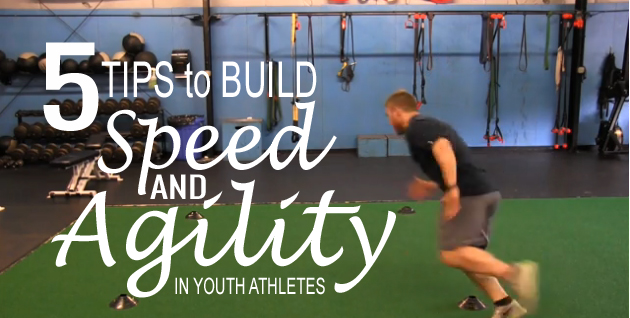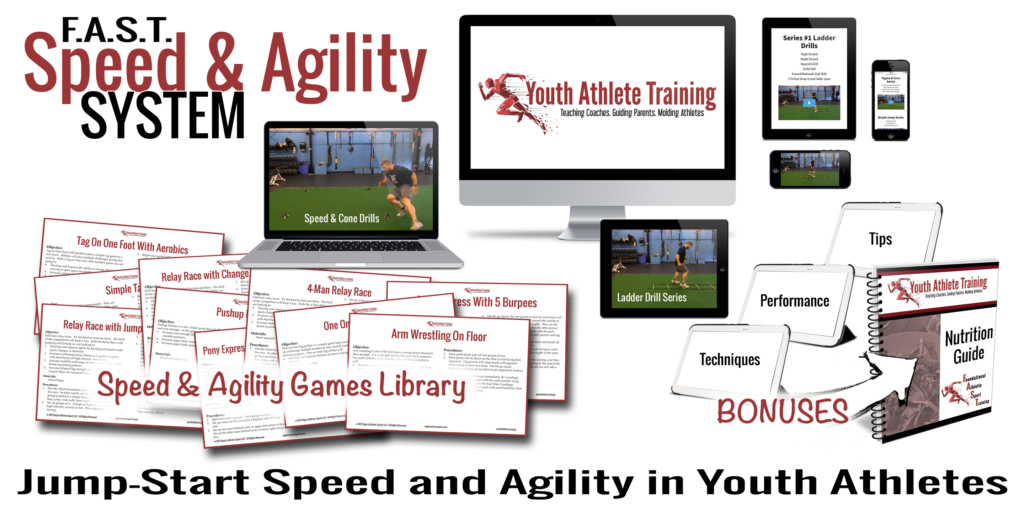Wondering how to increase speed and agility in youth athletes?
Frustrated with youth athletes lack of motivation and ability to stick with a program?
Athletes need a jump-start to increase their sports performance?
You may have answered yes to one, two or all three of these questions.
I want to give you five quick tips to help build speed and agility in youth athletes. But first, I need you to answer a question:
Are you trying to train youth athletes like adults?
Seriously, are you pushing them with advanced training systems designed for older athletes?
If so, first consider that youth athletes need training for stage specific growth and development. You wouldn’t expect your twelve year old to drive a car. Don’t expect a kid to behave like an older, mature athlete with an age-appropriate hormonal and muscular response to training.
Don’t use complicated training systems with youth athletes. These ‘wiz-bang’ systems miss out on key developments that can be obtained for long-term speed, agility and athleticism.
With that in mind, here are…
5 Tips To Increase Speed And Agility

1. Increase “Age-Appropriate” Strength:
All things being equal, a stronger muscle is a faster muscle. But, sending a youth athlete to the weight room to hammer out squats, benches and curls may be ineffective … and can lead to injury and burnout.
Youth athletes can be categorized into THREE major school levels: Elementary School, Middle School and High School. The training for an athlete in Elementary or Middle School is different than training for a High School athlete. Each level has unique growth and developmental stages, requiring different types of training and exercises to maximize sports speed.
When youth athletes perform age-appropriate resistance or strength training, strength is increased in the correct muscles, increasing speed and quickness. The F.A.S.T. Foundational Strength Training System is designed to individualize strength training for Elementary, Middle and High School athletes.
2. Games, Games, Games:
Youth athletes love games. They love to play. Kids learn through play. Games are a great way to engage youth athletes. But don’t mistake using games for wasted time. On the contrary, games reinforce the skills of their sport. They can be the actual skills used in the their sport or fun variations of those skills.
Game Tip #1: Get the kids using both sides of their body as much as possible. If your athletes are throwing athletes, have them throw with their opposite hand. If they kick with one foot, make them use the non-dominant side during the game.
Game Tip #2: Use variety as much as possible when setting up games. Get creative. Find out what games they are playing on their phone and come up with an ‘in real life version’.
Game Tip #3: Keep the athletes moving. I never use elimination games or games where someone is “out.” Why would I want them to sit down and do nothing but watch? They feel dejected. They aren’t exercising and they aren’t reinforcing skills. If they get caught or tagged have them move to the side of the playing area and perform an exercise like 5 pushups before returning to game.
Download This Sample Game: Pony Express
3. Introduce Change of Direction:
Often times, coaches and parents concentrate on linear speed. Perhaps this is because an athlete’s “40 meter” time is a way of measuring their ability. But in reality… how often in sports (other than Track and Field) do athletes run in a straight direction?
Most athletes have to move in all over the field or court, making quick changes of direction.
This is why youth athletes should drill with cones and ladders to promote change of direction.
The best part? They have a lot of fun doing it. Youth athletes enjoy the challenge of following cues to change directions.
Here’s a sample video:
4. Introduce Deceleration:
The sad truth about non-impact injuries is that most of them occur when landing after jumping or slowing down after running full speed. This landing or slowing is referred to as deceleration.
Deceleration is vital to train. One of the main goals of training is to reduce the risk of injury along with improving performance.
Here’s a simple drill you can do with your athletes to teach deceleration. Have them jump up as high as possible on one leg and land on the same leg. Immediately have them lower the opposite foot to the ground but taking 3 full seconds to lower it before it touches. Then take 3 additional seconds to lower into a full squat with both legs. Repeat by jumping off the same leg. Do 8 reps on each side.
Athletes gain an appreciation for the balance and control necessary to accelerate and then immediately decelerate.
5. Spice it Up:
Boredom breeds a lack of interest and motivation.
Keep things interesting and fun…
Use different ladder and cone drills for speed training. Use different games at the end of practice that promote skills and increase strength, yet are challenging and fun for them.
Including different ladder and/or cone drills at each practice will keep their minds stimulated along with increasing speed and quickness. Sometimes you’ll want to revisit a past drill so they can improve. Just be sure to throw in new ones. Don’t let anything “get old” or you’ll lose their interest.
If you run a regimented practice, try adding a cool game at the end or get creative with your drills. Let your athletes know at the beginning of practice what your expectations are. Tell them the “game of the day.” You’ll be amazed at how hard they’ll work for that reward at the end of practice!
I hope you found these tips helpful. Helping youth athletes increase speed and agility is a mental challenge as well as a physical workout. Kids need to have fun when training. If you make it fun and make it effective, their speed, agility and long-term athleticism will increase tremendously.
If you’d like a blueprint for increasing the speed and agility of your youth athletes be sure to check out our F.A.S.T. Speed and Agility System – Jumpstart Speed and Agility in Youth Athletes!



8 thoughts on “5 Tips to Build Speed and Agility In Youth Athletes”
Comments are closed.